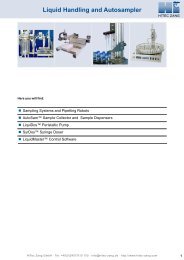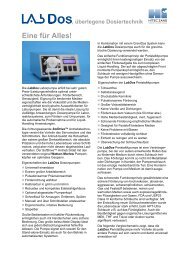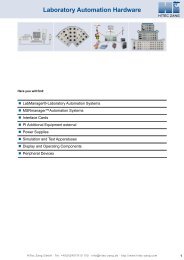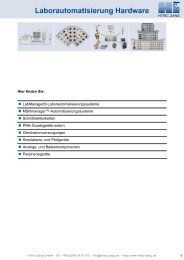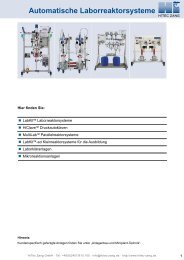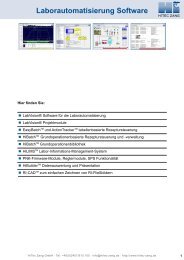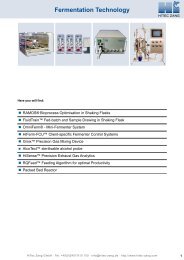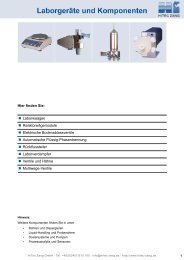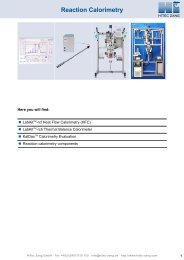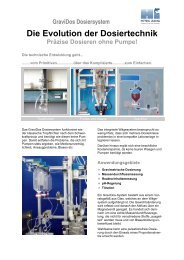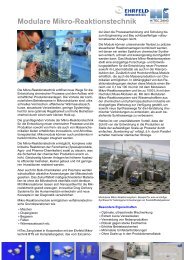- Page 2 and 3: HiTec Zang GmbH • Ebertstrasse 30
- Page 4 and 5: 4 New in this Edition 30 Years of E
- Page 6 and 7: 6 Automatic Laboratory Reactor Syst
- Page 8 and 9: 8 Automatic Laboratory Reactor Syst
- Page 10 and 11: 10 Standard Systems Automatic Labor
- Page 12 and 13: 12 Automatic Laboratory Reactor Sys
- Page 14 and 15: 14 Automatic Laboratory Reactor Sys
- Page 16 and 17: 16 Automatic Laboratory Reactor Sys
- Page 18 and 19: 18 Automatic Laboratory Reactor Sys
- Page 20 and 21: 20 Automatic Laboratory Reactor Sys
- Page 22 and 23: 22 Automatic Laboratory Reactor Sys
- Page 24 and 25: 24 Special Features Automatic Labor
- Page 26 and 27: 26 Here you will find: � LabKit T
- Page 28 and 29: 28 Reaction Calorimetry LabKit-rcf
- Page 32 and 33: 32 Reaction Calorimetry Calorimetry
- Page 34 and 35: 34 Reaction Calorimetry Components
- Page 36 and 37: 36 Here you will find: Fermentation
- Page 38 and 39: 38 The demand for equal cultivation
- Page 40 and 41: 40 Fermentation Technology Feeding
- Page 42 and 43: 42 Technical Data Fermentation Tech
- Page 44 and 45: 44 An user-friendly interface and a
- Page 46 and 47: 46 Technical Data (Gas Mixing Devic
- Page 48 and 49: 48 Fermentation Technology OxyTect
- Page 50 and 51: 50 Technical Data (HiSense-m for mi
- Page 52 and 53: 52 Fermentation Technology RQFeed F
- Page 54 and 55: 54 Here you will find: Laboratory A
- Page 56 and 57: 56 Areas of Application Laboratory
- Page 58 and 59: 58 Laboratory Automation Hardware C
- Page 60 and 61: 60 System Assembly Laboratory Autom
- Page 62 and 63: 62 Laboratory Automation Hardware M
- Page 64 and 65: 64 Laboratory Automation Hardware A
- Page 66 and 67: 66 Instrumentation Laboratory Autom
- Page 68 and 69: 68 LabBox1 and 2 Laboratory Automat
- Page 70 and 71: 70 Laboratory Automation Hardware L
- Page 72 and 73: 72 Standard Devices Laboratory Auto
- Page 74 and 75: 74 Laboratory Automation Hardware L
- Page 76 and 77: 76 LabBox Basis Device Laboratory A
- Page 78 and 79: 78 Laboratory Automation Hardware L
- Page 80 and 81:
80 Laboratory Automation Hardware L
- Page 82 and 83:
82 Outstations (LZ-USTAT) Laborator
- Page 84 and 85:
84 Task, sensor intended for connec
- Page 86 and 87:
86 Laboratory Automation Hardware W
- Page 88 and 89:
88 Technical Data Laboratory Automa
- Page 90 and 91:
90 Laboratory Automation Hardware 8
- Page 92 and 93:
92 Laboratory Automation Hardware D
- Page 94 and 95:
94 Laboratory Automation Hardware I
- Page 96 and 97:
96 Interface panels for digital inp
- Page 98 and 99:
98 Interface Panels for Digital Out
- Page 100 and 101:
100 Technical Data Laboratory Autom
- Page 102 and 103:
102 Serial Interfaces Laboratory Au
- Page 104 and 105:
104 Laboratory Automation Hardware
- Page 106 and 107:
106 Laboratory Automation Hardware
- Page 108 and 109:
108 Laboratory Automation Hardware
- Page 110 and 111:
110 Laboratory Automation Hardware
- Page 112 and 113:
112 Laboratory Automation Hardware
- Page 114 and 115:
114 Free standing mounting installa
- Page 116 and 117:
116 MSRbox Basic Device Laboratory
- Page 118 and 119:
118 Laboratory Automation Hardware
- Page 120 and 121:
120 Laboratory Automation Hardware
- Page 122 and 123:
122 Multiplexer Cards Laboratory Au
- Page 124 and 125:
124 Laboratory Automation Hardware
- Page 126 and 127:
126 Laboratory Automation Hardware
- Page 128 and 129:
128 PI Additional Devices Laborator
- Page 130 and 131:
130 Technical Data Laboratory Autom
- Page 132 and 133:
132 Laboratory Automation Hardware
- Page 134 and 135:
134 Simulation Devices Pt100 Simula
- Page 136 and 137:
136 Casing Design Laboratory Automa
- Page 138 and 139:
138 Fileserver Laboratory Automatio
- Page 140 and 141:
140 Periphery Laboratory Automation
- Page 142 and 143:
142 LabVision® Advantages Laborato
- Page 144 and 145:
144 Laboratory Automation Software
- Page 146 and 147:
146 Module as Light-Version Laborat
- Page 148 and 149:
148 The Multi-Plotter System Labora
- Page 150 and 151:
150 The Online Chart Laboratory Aut
- Page 152 and 153:
152 Laboratory Automation Software
- Page 154 and 155:
154 Laboratory Automation Software
- Page 156 and 157:
156 P&ID-Editor Laboratory Automati
- Page 158 and 159:
158 Multi-LabCam System Laboratory
- Page 160 and 161:
160 Laboratory Automation Software
- Page 162 and 163:
162 Laboratory Automation Software
- Page 164 and 165:
164 Laboratory Automation Software
- Page 166 and 167:
166 Basic Operations Library Labora
- Page 168 and 169:
168 Individual Basic Operations (co
- Page 170 and 171:
170 Laboratory Automation Software
- Page 172 and 173:
172 Data Export Laboratory Automati
- Page 174 and 175:
174 Laboratory Automation Software
- Page 176 and 177:
176 LabVision ® standard packets L
- Page 178 and 179:
178 Laboratory Automation Software
- Page 180 and 181:
180 Laboratory Automation Software
- Page 182 and 183:
182 Elements of the Search Dialogue
- Page 184 and 185:
184 PI-Firmware-Modules Laboratory
- Page 186 and 187:
186 Adaptive Regulation with HiCon
- Page 188 and 189:
188 Data Types Laboratory Automatio
- Page 190 and 191:
190 Laboratory Automation Software
- Page 192 and 193:
192 Laboratory Automation Software
- Page 194 and 195:
194 Plant Construction and Miniplan
- Page 196 and 197:
196 Dosing Systems Plant Constructi
- Page 198 and 199:
198 Plant Construction and Miniplan
- Page 200 and 201:
200 Plant Construction and Miniplan
- Page 202 and 203:
202 Plant Construction and Miniplan
- Page 204 and 205:
204 Plant Construction and Miniplan
- Page 206 and 207:
206 Laboratory Scales HiTec Zang is
- Page 208 and 209:
208 Reactor Weighing Equipment and
- Page 210 and 211:
210 Equipment and Components Electr
- Page 212 and 213:
212 Glass Components Reflux Separat
- Page 214 and 215:
214 Valves and Stop-Cocks Valves, s
- Page 216 and 217:
216 Universal Laboratory Valve This
- Page 218 and 219:
218 Inerting, Venting and Deairing
- Page 220 and 221:
220 Adjustment and Control Valves E
- Page 222 and 223:
222 Equipment and Components Order
- Page 224 and 225:
224 Process Analytics and Sensors H
- Page 226 and 227:
226 Process Analytics and Sensors T
- Page 228 and 229:
228 Pharmaceuticals: Caffein, Ascor
- Page 230 and 231:
230 Sensors Available are dynamic 2
- Page 232 and 233:
232 Technical Data: Configuration E
- Page 234 and 235:
234 Process Analytics and Sensors F
- Page 236 and 237:
236 Level Sensor Robust high-qualit
- Page 238 and 239:
238 The Functional Principle Proces
- Page 240 and 241:
240 Process Analytics and Sensors S
- Page 242 and 243:
242 Process Analytics and Sensors P
- Page 244 and 245:
244 Process Analytics and Sensors M
- Page 246 and 247:
246 Technical Data Process Analytic
- Page 248 and 249:
248 Models and Flow Ranges Mass Flo
- Page 250 and 251:
250 Temperature Sensors Pt100 Senso
- Page 252 and 253:
252 Process Analytics and Sensors L
- Page 254 and 255:
254 Humidity Sensors Process Analyt
- Page 256 and 257:
256 Monitors Process Analytics and
- Page 258 and 259:
258 Pressure Monitor Process Analyt
- Page 260 and 261:
260 Filling Level Monitor Optically
- Page 262 and 263:
262 Technical Data: Process Analyti
- Page 264 and 265:
264 Dosing Systems and Pumps Contro
- Page 266 and 267:
266 GraviDos ® suspended balance D
- Page 268 and 269:
268 Dosing Systems and Pumps Contro
- Page 270 and 271:
270 Dosing Systems and Pumps IP-P-S
- Page 272 and 273:
272 The following comparative matri
- Page 274 and 275:
274 Dosing Systems and Pumps Order
- Page 276 and 277:
276 Dosing Systems and Pumps Maximu
- Page 278 and 279:
278 Dosing Systems and Pumps Order
- Page 280 and 281:
280 LabDos Piston Dosing Pump Valve
- Page 282 and 283:
282 SyrDos2 Syringe Doser The SyrDo
- Page 284 and 285:
284 Pneumatic Dosing Pumps Modotec
- Page 286 and 287:
286 Magnetic dosing pump Magnetic d
- Page 288 and 289:
288 Ex-Magnetic Membrane Dosing Pum
- Page 290 and 291:
290 Dosing Systems and Pumps High P
- Page 292 and 293:
292 Toothed Ring Pumps Toothed ring
- Page 294 and 295:
294 Centrifugal Pumps Centrifugal P
- Page 296 and 297:
296 Reaction Proportioning Pumps Re
- Page 298 and 299:
298 Vacuum pumps Membrane vacuum pu
- Page 300 and 301:
300 Vacuum Pump Stand These laborat
- Page 302 and 303:
302 Versions Dosing Systems and Pum
- Page 304 and 305:
304 Dosing Systems and Pumps SoliDo
- Page 306 and 307:
306 Liquid Handling and Autosampler
- Page 308 and 309:
308 AutoSam300 Liquid Handling and
- Page 310 and 311:
310 AutoSam495 Liquid Handling and
- Page 312 and 313:
312 Accessories, Options 2/3-Way Va
- Page 314 and 315:
314 Stand-alone use Liquid Handling
- Page 316 and 317:
316 Liquid Handling and Autosampler
- Page 318 and 319:
318 Liquid Handling and Autosampler
- Page 320 and 321:
320 Stirring and Dispersing Measuri
- Page 322 and 323:
322 ViscoPakt ® -rheo The ViscoPak
- Page 324 and 325:
324 ViscoPakt ® -mini-rheo-35 Stir
- Page 326 and 327:
326 ViscoTrol rheo The activation v
- Page 328 and 329:
328 Bellows couplings In order to b
- Page 330 and 331:
330 Stirring and Dispersing Stirrer
- Page 332 and 333:
332 Stirring and Dispersing Dispers
- Page 334 and 335:
334 Services HiTec Zang - Your comp
- Page 336 and 337:
336 Seminars and Training The conti
- Page 338 and 339:
338 Product Manuals The manuals to
- Page 340 and 341:
340 IL-ALCOTECT-d-l................
- Page 342 and 343:
342 IR-VIPA27......................
- Page 344 and 345:
344 LP-PEAPSK24....................
- Page 346 and 347:
346 SL-PNKMBUSSER..................
- Page 348 and 349:
348 Table of Content New in this Ed




